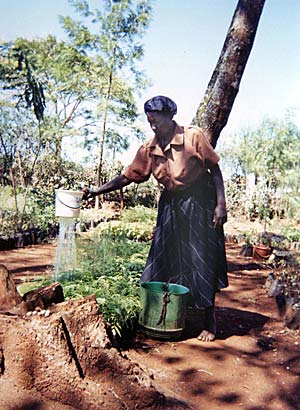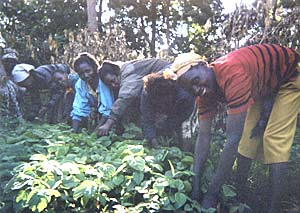Part I: How to Persuade 100 Thousand Poor People to Plant Trees
Air Date: Week of July 1, 2005

Wangari Maathai on a hillside in Kenya, 2004. (Photo: Mia McDonald, Friends of the Green Belt Movement North America)
Kenya has offered the world a new model for what an environmental movement can be, one that harnesses the power of thousands of hands. Even the hands of people with little means. In 2004 the Norwegian Nobel Committee recognized this new model and its founder, Kenyan scientist and environmentalist Wangari Maathai. In the first part of this special edition of Living on Earth, Ingrid Lobet introduces us to the basic mechanics of the Green Belt tree planting movement and its Nobel Prize winning founder.
Transcript
CURWOOD: From the Jennifer and Ted Stanley Studios in Somerville, Massachusetts, this is Living on Earth. I’m Steve Curwood. In 2004, for the very first time in its history, the Nobel Committee awarded its prestigious Peace Prize to an environmental activist.
The winner was a scientist and an African woman. Her name: Wangari Maathai. Perhaps you've heard of the Green Belt Movement she founded to reforest the landscape of her East African nation.
In today’s program we ask two questions: Who is Wangari Maathai and why has her Green Belt Movement blossomed? Wangari Maathai says she had little idea in the beginning that teaching women to plant trees would not just demystify forestry, but would also change the lives of women and help clean up government as well. Living on Earth’s Ingrid Lobet has our story of how this very Kenyan approach to environmental activism may hold lessons for the rest of the world.
LOBET: A boundary of coffee, mango and papaya trees encircles a steep hillside in Kenya's Central Highlands. The ground is packed with seedlings, their roots wrapped in black plastic. On any morning, in 3500 nurseries like this one across central Kenya, volunteers tend their prospects. Heisal Bangui and a group of her neighbors shows me how they do it.

Eunice Nyokabi at her nursery in Ruiru, Kenya, watering a few of her 30 to 50 thousand seedlings. (Photo: Ingrid Lobet)
BANGUI: We take an empty, an empty bag, we fill with soil. We have mixed the soil with the manure and we fill and we do like that. After watering, we take seed, we put, we make a hole with finger, then we insert. We insert the seed inside here, then we water again.
LOBET: Nurseries like this one are the core of the Green Belt Movement. They begin with a call or letter to the Movement office in the capital Nairobi. Green Belt tells them: “Find a meeting room in your school or church and invite everyone.” Then a staff member goes to the meeting and helps the community choose the most gung ho or best organized among them to be leaders. People learn to collect tree seeds and how to choose a nursery plot. They prepare the ground. Then the Movement gives them the precious black polyethylene tubes for tamping in the soil, the African version of the cardboard seedling pot.
LOBET: Heisal and her friends lead me over to a hand-dug hole, about six-feet deep.
BANGUI: This is where we get water for watering. We use the can... this is the can we use.
LOBET: To get water you must step steeply down into the hole, brace your feet against its dirt sides, bend over, and fill the bucket below your feet, then swing the 20 pounds of water over your head, then up onto the ground. And you must do this for two hours at a time, twice a day until the seedlings are six inches high.
BANGUI: Oooh. Ah, this is what we do daily.
[LAUGHTER]
BANGUI: This is what we do.
[SOUND OF WATER BEING POURED]
LOBET: When the plants are one foot tall, they carry them to be planted.
BANGUI: And then we use sacks. We put about 20, and then we use our back.
LOBET: They carry the 40-or-so-pound sacks of seedlings up the hillside strapped to their foreheads.
BANGUI: You see the place is steep. So we come more than 10 times, yeah, going up and down, carrying this heavy nini. We carry 20. 20 seedlings. Just 20. And it is heavy. They are heavy because the soil, the soil is wet. Yeah, that is what we do, mmm. We feel it is our work so we can’t get tired. We can see the fruit of the work we are doing.
|
LOBET: The young trees go to members’ homes, for future firewood or shade. They go to neighbors, nearby schools, and, nowadays, to rehabilitate Kenya's ragged forests. Wherever they go, these seedlings are free, but the person receiving them must dig all the holes--a show of commitment. Green Belt members continue to tend the baby trees for three months. Then the office in Nairobi pays them an amount that's small, but crucial-- five shillings-- about seven cents a seedling. These acts of reforestation reverberate within Kenyans and their society. And the Movement has confronted the government armed with seedlings and been viewed as subversive. Once was in 1996, when Green Belt founder Wangari Maathai and her supporters, armed with seedlings, staged a series of protests at Karura National Forest, a 2600 acre wood on the northern outskirts of Nairobi. It turned out then-president Daniel Arap Moi was selling off pieces of forest to his backers. SOUTH AFRICAN NEWSWOMAN: The crowds approaching the gates of Karura are each being met by a huge police blockade. MUCHUNGI: Yeah, that day I saw death. LOBET: Lillian Muchungi is a Green Belt organizer and mother of two. And, as usual, she was with Wangari Maathai on this day to retake Karura symbolically by planting. MUCHUNGI: I was standing right next to her. That was the day I thought: maybe one day we will die over Karura. But she said there then, “on my dead body that Karura will ever be subdivided to individuals.” LOBET: A crowd of young security guards, hired to keep the protesters at bay, waited a few yards away on the other side of a fence. MUCHUNGI: When I looked at them, I knew these guys were going to beat us. They were carrying knives. They were carrying some daggers, you know, those very sharp pieces of wood and some whips, and machetes, you know. And I wanted to protect her and I wanted to talk to her to ask her not to do it and maybe go back, maybe get back there another time but she insisted, "this is the day that we are going to plant this tree. We must do it today.” LOBET: A South African news team was on hand to record the standoff. Wangari Maathai held a seedling in one hand and a wooden crucifix in the other. MAATHAI: As you can see, I am holding the power of Christ. I am quite sure that the anti-Christ will not keep us away from the forest. This is the power that the man who died on this cross did not believe in and I don't either. MUCHUNGI: And she was trying to dig a hole. That is when they all jumped over the fence. And some were on her with whips and some very sharp daggers. Ten, ten young men, yes, were on us! MUCHUNGI: I was hit with a big stone here, I remember. And for her, she was now... One of them landed on her head with one of the sharp objects and when I saw blood, I started screaming, but others were on her now with the whips, from all the sides. LOBET: Maathai's head injury required stitching; she was released from the hospital a few days later. University students later joined the protests. The names of some involved in the real estate transactions were published and forest development halted. [BIRDSONG] LOBET: Where does a movement that can change a country begin? Maathai often recalls the heavily wooded hills of Nyeri where she was born. MAATHAI: I grew up in a beautiful part of the country. Full of trees, full of food, a lot of happiness, a lot of water, a lot of firewood, a lot of building material. Everything that I am now trying to replenish, there was plenty of it when I was a child. [BIRDSONG] LOBET: Wangari's Maathai's mother also planted. She sent her daughter to school in the 1940s. In middle and high school her teachers were nuns and Maathai said she learned from their model of life in service to others. Then she traveled to Kansas to major in biology at a Catholic college, then more study in Pittsburgh and Germany and back home. MAATHAI: In Nairobi, I pursued a Ph.D in anatomy in the early 70s. It seemed as though besides being a wife and mother I was destined to be a university professor, to help produce graduates of veterinary medicine who would feed the nation and East Africa with the products from the livestock industry. [‘70s MUSIC] LOBET: It was an exciting time to be Kenyan. Independence from Britain was a decade past. A young scientist wanted to advance her people. Wangari Maathai focused on livestock. She studied the brown ear tick, collecting thousands of them in the countryside in the hope of alleviating Rhinderpest, a fatal East African cattle fever. [AFRICAN SINGING] MAATHAI: When I was collecting ticks I saw environmental degradation in my country. I noticed the animals from which I collected the ticks were thin and clearly suffering from hunger. There was little grass and other fodder . Rivers were low. This information was hitting me from all angles. LOBET: Maathai saw the signs in the countryside and heard discussions about hunger at the National Council of Women of Kenya. MAATHAI: I realized the real threat to cattle in my country was not the brown eared tick, but the deteriorating environment around me. I also recognized that not only the livestock industry, but me, my children, my students and my entire country were threatened by a deteriorating environment. Deforestation, soil loss, pollution, and non-sustainable management of the land. At one seminar, I was struck that children from the central part of Kenya where I grew up, amongst plenty, were suffering from malnutrition. LOBET: Kenyan women were seeking faster-cooking meals because firewood was getting harder to find. What the British colonists had begun--cutting timber to build the East African railway--rural women were continuing in their search for fuel. MAATHAI: I listened to the women from the rural areas, and I noticed that the issues they were raising had something to do with the land. They were asking for firewood, they need clean drinking water, they needed food, they needed income because they were poor. I immediately understood that what we really needed to address those problems is to rehabilitate the environment. I started encouraging women that we plant trees. That's how it all started. [WOMEN SINGING] LOBET: Though it wasn't clear at the time, Wangari Maathai and the National Council of Women of Kenya were inventing a playbook, an operating manual not just for planting trees but for transforming the lives of Kenyan women. But to do so they had to enter the province of men, the nation's professional foresters. They weren't always eager to share their knowledge. Maathai sought then, as she would many times, to disarm the opposition, telling them, "we’re just a bunch of women planting trees." CURWOOD: Coming up, we'll hear how the Green Belt Movement and its founder Wangari Maathai reforested whole regions of Kenya and, in the process, drew the wrath of the Kenyan government. Keep listening to Living on Earth. Living on Earth wants to hear from you!Living on Earth Newsletter [Click here]
Donate to Living on Earth! NewsletterLiving on Earth offers a weekly delivery of the show's rundown to your mailbox. Sign up for our newsletter today!
|






